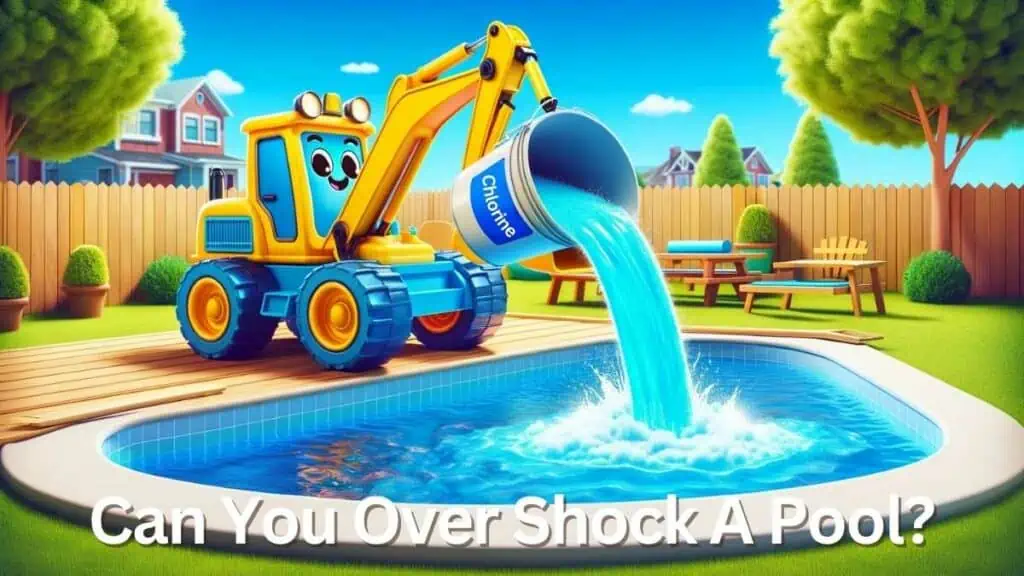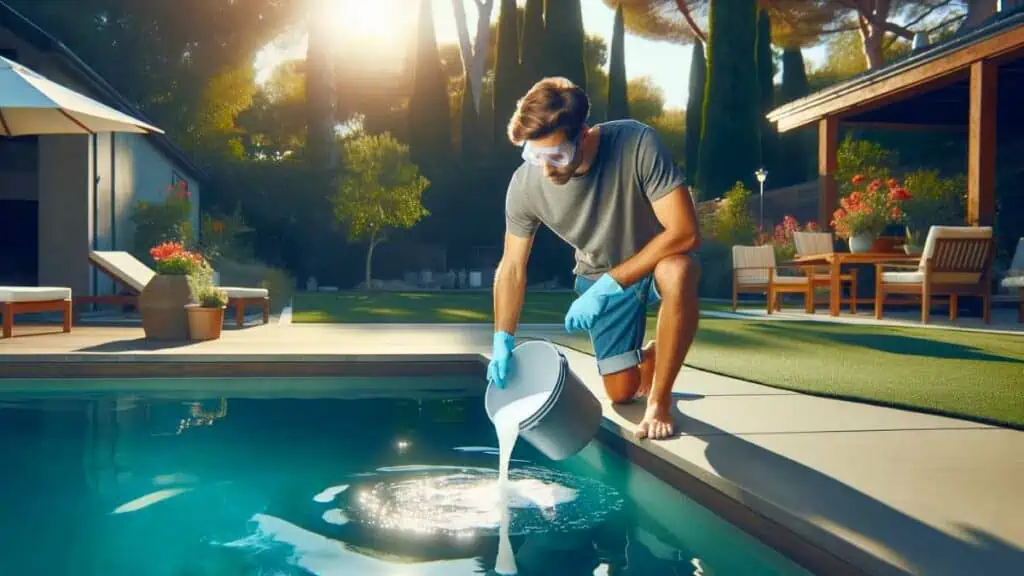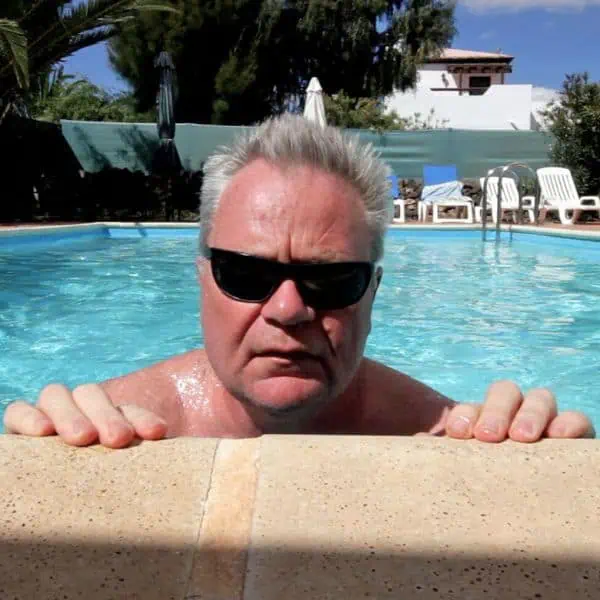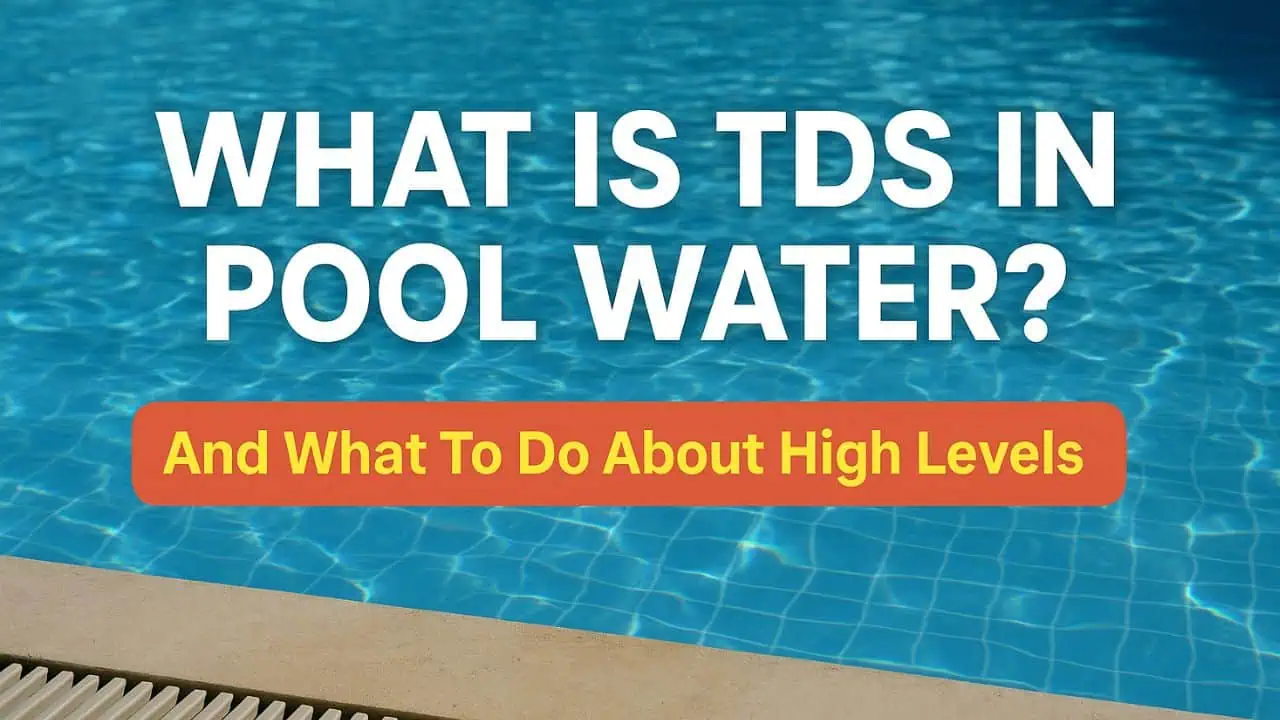One question that many pool owners ask is: Can you over shock a pool?
Over shocking might seem like a good solution to murky waters or persistent algae, but the ripple effects can be surprising and far-reaching.
In this comprehensive post, we’ll unravel the myths, dive into the science of pool chemistry, and provide you with clear, actionable advice to ensure your pool remains a sparkling oasis without the sting of too much chlorine.
Whether you’re a first-time pool owner or a seasoned swimmer, understanding the delicate balance of pool shocking is key to a blissful, refreshing dive every time.

Key Takeaways
- Overshocking Consequences: Excessive shock can irritate swimmers and damage pool equipment by disrupting water pH levels.
- Chemical Balance: Too much shock can lead to pH imbalance, scaling, and cloudiness due to high calcium and cyanuric acid levels.
- Shocking Guidelines: Use shock at night, prefer liquid shock, and maintain regular cleaning to minimize the need for shock treatments.
- Shock Varieties: Choose from calcium hypochlorite, sodium dichlor, or liquid chlorine, each with different application methods.
- Post-Shock Testing: Test water 24 hours after shocking to ensure chlorine levels are safe for swimming (1-3 ppm).
Can you over shock a pool?
Overshocking a pool, also known as superchlorination, is a common practice for pool maintenance, especially when dealing with algae blooms, contamination, or other issues requiring a high chlorine level to clean the water.
However, it’s possible to “over shock” a pool, leading to potential problems.
When you over shock a pool, the chlorine levels become excessively high. This can lead to several issues.
- Firstly, it can irritate a swimmer’s skin, eyes, and respiratory system, causing discomfort or health concerns.
- Secondly, extremely high chlorine levels can disrupt the pH balance of the pool water, making it either too acidic or too alkaline, which further affects water quality and comfort.
- Additionally, excessive chlorine can damage pool components, such as liners, filters, and ladders, leading to costly repairs or replacements.
What might happen if you add too much pool shock to a swimming pool?
The only downside to adding too much is that it can upset the pH balance of the pool water and increase the amount of time before it is safe for bathers to use the pool again.
Pool shock adds more chlorine to the water, which can either increase or decrease pH levels. This imbalance means the chlorine is not as effective, which can lead to algae growth and damage to the pool. So, what are the potential risks?
An imbalance of pH levels can lead to:
- Corrosion of pool equipment such as pool ladders, handlebars, etc.
- It can cause a build-up of scale along pool walls and equipment.
Other risks of over shocking
As discussed above, even though over-shocking your pool won’t do any harm in the short term, you shouldn’t continue to use shock treatments unnecessarily.
Cloudy water relies on three factors: pH levels, calcium hardness, and cyanuric acid levels. Let’s find out how adding too much chlorine, or pool shock, can affect these.
High calcium hardness levels
If your pool already has high calcium hardness levels, adding pool shock won’t do you any favors. This can lead to a build of scale along pool walls and equipment. Cloudy water is also a tell-tale sign of high calcium levels.
Excess cyanuric acid
Sodium dichlor is the best way to level out the amount of cyanuric acid in the water. Again, an excessive amount of this chemical will lead to cloudiness.
Pool shock: How much is needed
The standard measurement is to dissolve a pound of sodium dichlor or calcium hypochlorite for every 10,000 gallons of water. Using sodium hypochlorite or liquid chlorine, you must dissolve around 10 ounces per 10,000 gallons of pool water.
Now comes the tricky part: finding out how many gallons of water your pool can hold. If you still have the pool manufacturer’s booklet, you will probably find this information on the pages. If not, you can use this simple calculation:
Length of pool X Width X Depth X 7.5 = Total volume in gallons. Or you can use our handy pool volume calculator.
Pool Volume Calculator
Please enter your pool shape and dimensions:
Tips for successfully shocking your pool

Knowing the most common pool maintenance mistakes will help keep your pool safer and more enjoyable. Here are some tips for shock-proofing your pool correctly.
Tip 1: Add the shock in the evening
Adding pool shock when the sun goes down gives the chemicals a good chance of sticking around. Natural sunlight can evaporate almost all chlorine in your pool in a few hours.
While most pool owners use a solar cover, administering pool shock after dark ensures there isn’t even one slither of sunlight in your pool water.
Tip 2: Liquid over powder shock, always
Powder shock can sometimes leave your pool looking cloudy, leading to the addition of more shock. Liquid pool shock doesn’t seem to have this effect on the water. However, both products work to kill off bacteria and algae.
Tip 3: Regularly clean your pool
I hate to say it repeatedly, but keeping on top of your pool cleaning schedule works wonders. This, in turn, will reduce the overall amount of pool shock needed.
Wiping the tiles, using an automatic pool vacuum, and asking family members and visitors to shower before making a splash will make a huge difference.
Tip 4: Test pool pump and filter beforehand
Before adding the shock treatment, ensure the pump and filter work well. This is important because once the pool shock is added, the pump and filter work to disperse it evenly around the pool.
You should always leave the pump running overnight to maintain circulation. Otherwise, the pool shock may only be effective in certain areas of the water.
Different types of pool shock
Like any other product on the market, people are drawn to different brands for different reasons. Let’s examine the types of pool shock available.
Calcium hypochlorite
Produced in granular form, calcium hypochlorite is often found in powder or tablet form. Regardless of the form you choose, you should always dilute this product in at least gallons of pool water before adding it to the pool itself.
Sodium dichlor
This is similar in composition to calcium hypochlorite with the addition of cyanuric acid (CYA).
Cyanuric acid is a useful component that protects when added to water. For example, chlorine levels can be reduced by up to 90% on a sunny day in just two hours. Cyanuric acid acts as a sunscreen and keeps the chlorine intact a little longer.
Sodium hypochlorite
Sodium hypochlorite, sometimes called liquid chlorine, is one of the most popular choices for pool shocking treatments. You can pour it directly into the pool without diluting the solution.
This product is also preferred because it doesn’t leave the water cloudy as granular products do.
Testing the pool after adding shock treatment
Patience is key after shocking your pool, and it takes around 24 hours to see a real difference. Don’t panic if the water seems even cloudier after adding the treatment. This is normal and a sign of the pH levels regulating themselves.
A chlorine test kit, or strip, is needed to test the water chemistry. We recommend testing before the sun comes out, as this can affect the chlorine levels. Running the pump for around 20 minutes will also allow the water to circulate so that the chemicals are evenly dispersed.
So, what is the best way to test the water?
- If possible, take a sample of water from the center of the pool. If this is inconvenient, remove water from the pool walls as far away as possible.
- If using a test kit, follow the instructions on the packaging. If using a test strip, you will need to dip it into the sample.
- Look at the strip against the color chart to see if your levels are up to scratch. Color charts differ from certain test strips, making them confusing to read. If you can see a reading of 1-3ppm, then this indicates your chlorine levels are safe.
Top Tip: Testing your pool too early can give inaccurate or false results, so wait at least 24 hours before testing.
Summary
While shocking a pool is essential to maintaining clean and safe water, overdoing it can lead to various problems. It’s crucial to follow the manufacturer’s instructions and test the water regularly to ensure the chlorine levels are within the safe and effective range.
If you are unsure about the process or how to handle a particular situation, consulting with a pool professional is always a wise choice to maintain the longevity and enjoyment of your swimming pool.
Pool Shocking FAQ Section
Have you still not found the answer to your question? Our FAQ section may be of help.
How Often Should I Use Pool Shock?
We recommend adding pool shock every couple of weeks during peak swimming times. If you live where the pool is in use all year round, we recommend every 3-4 weeks. For general pool maintenance, you should test the pool chemistry at least 2-3 times weekly.
Can I Under-Shock My Pool?
Yes, if you fail to add pool shock treatments to the water, the chemistry will be out of sync and may take a while to regulate itself again. You may even find that draining and refilling is easier than trying to balance it out with pool shock.
When Is The Best Time To Use Pool Shock?
Pool shock is a great product for cleaning your pool quickly. If you have friends and family over for a pool party, you will probably want to get the pool looking brand new, and that’s where pool shock comes in.
Similarly, pool shock is ideal for areas where the weather is quite volatile or if your backyard has many trees or plants that blow into the pool.





Leave a Reply